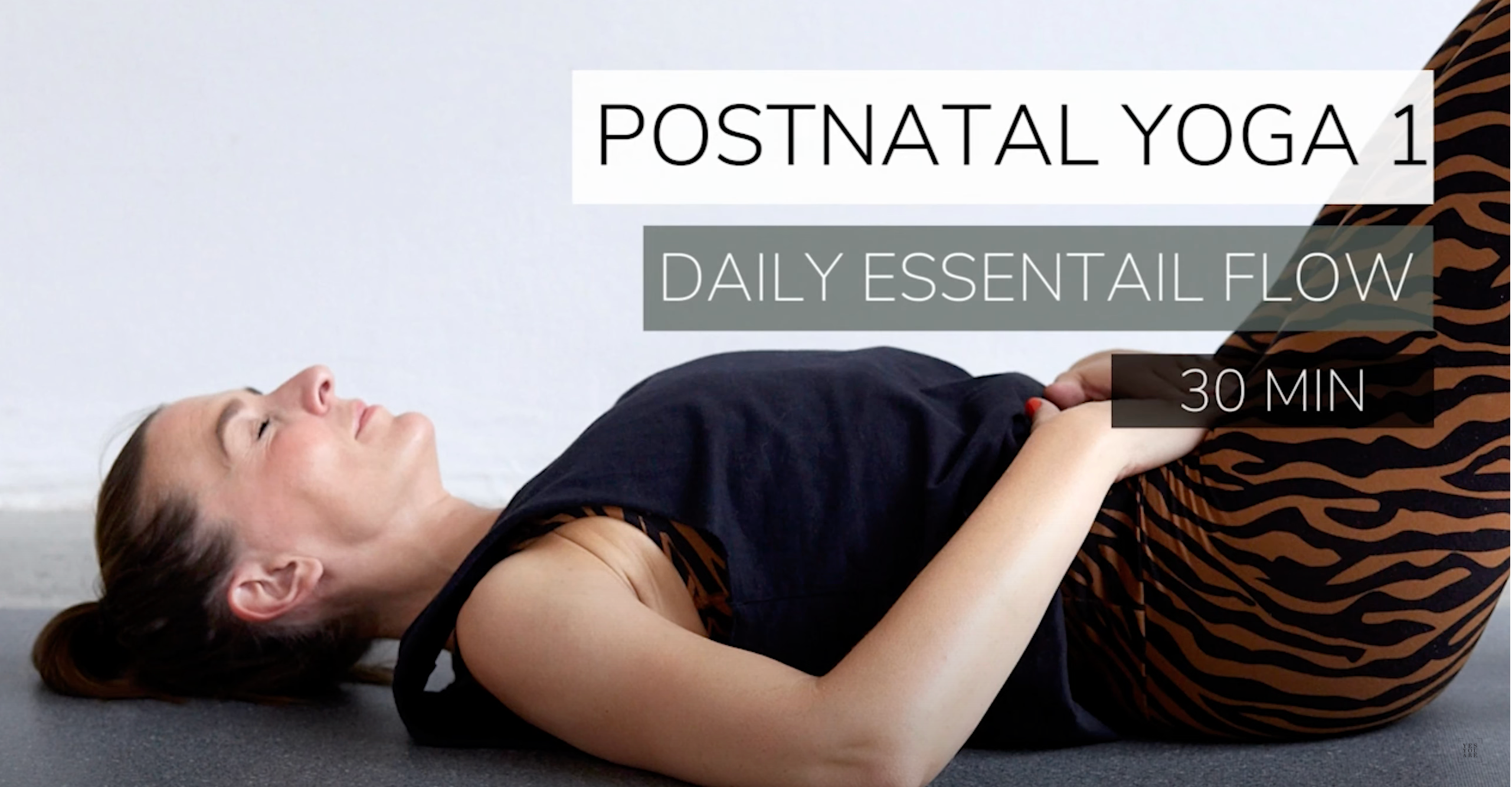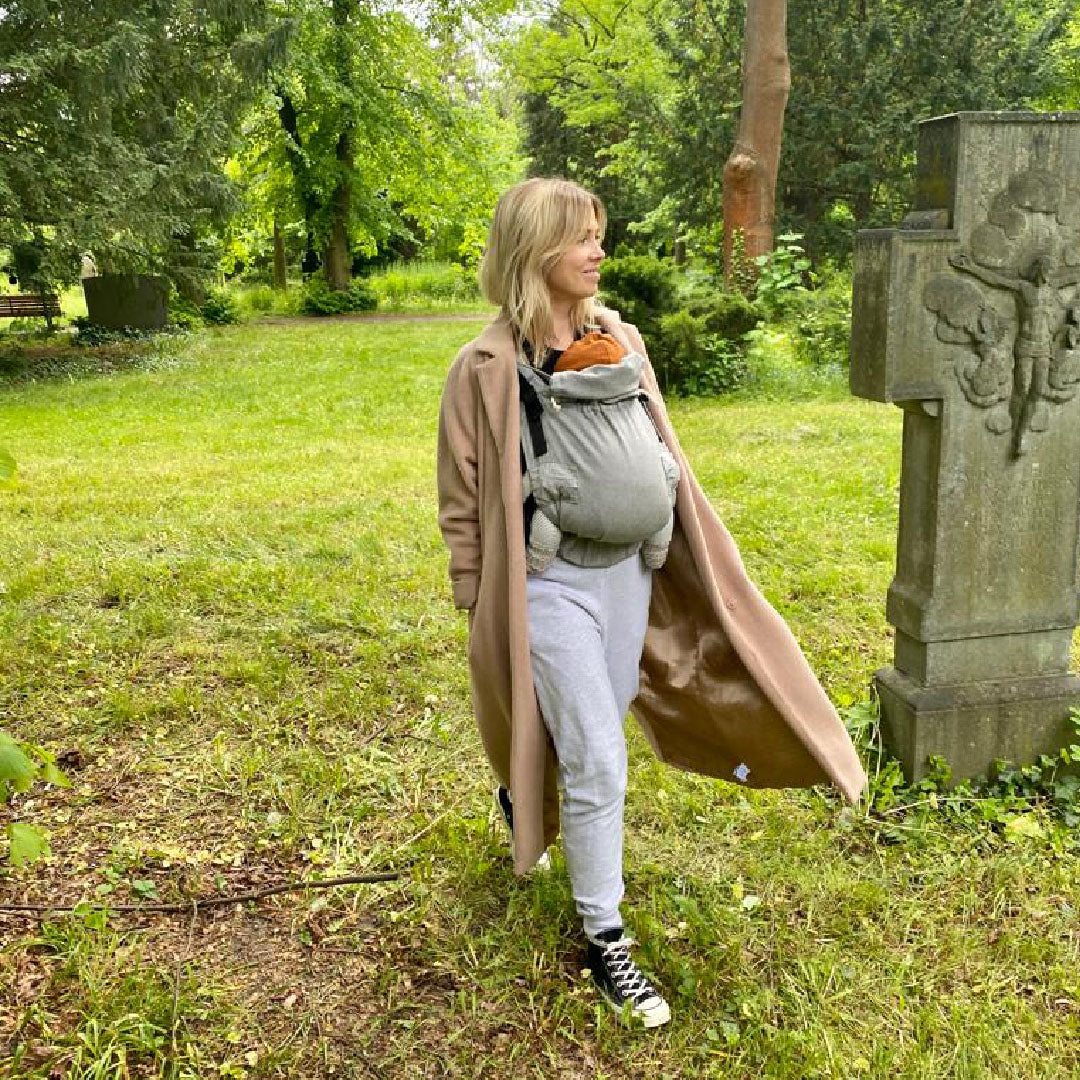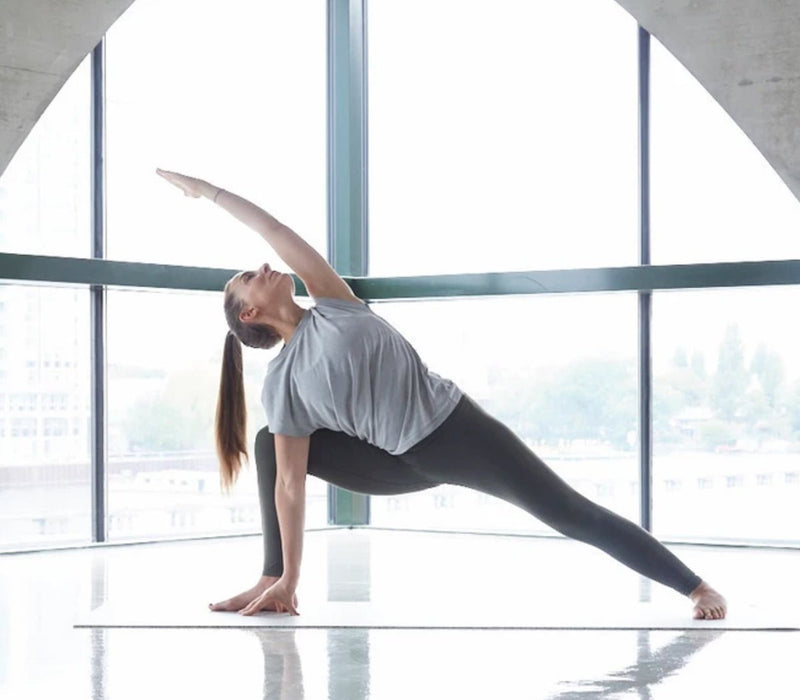“This body has created and nourished an entire human being. It is amazing, beautiful and worthy of love!"
(unknown)
Congratulations! You just had a baby or some time ago and are now wondering what you should consider when it comes to postnatal yoga or what exactly postnatal yoga is all about.
In this article you will get a few helpful tips for your everyday behavior and your yoga practice after the birth and you will find out which dos and don'ts to consider in postnatal yoga.
There are few bigger changes in a woman's life than becoming a mother. During the postpartum period, the first six to eight weeks after the birth, you can and should concentrate primarily on your newborn and otherwise allow yourself as much relaxation and rest as possible in order to process the birth in peace and to bond with the baby . The mother's organism needs this time to regenerate the changes caused by pregnancy and childbirth, as well as for the regression of all organs, for hormonal changes and wound healing.
Of course, gentle breathing exercises and activations for the pelvic floor can also be practiced during this time to support recovery.
It is important to emphasize here that every woman, every birth, every postpartum period and, accordingly, every recovery is different and very individual. It is therefore almost more important than with prenatal yoga to be accompanied by a trained teacher, midwife or physiotherapist.
In a holistic postnatal yoga class, the physical and psychological changes that motherhood entails are addressed in a targeted manner. The focus is on exercises that systematically strengthen and build up the pelvic floor and the abdominal and back muscles. The inner straightening, the length of the spine are offered as well as movement sequences for the shoulder and neck area. Hormonally sensitive joints are also gently mobilized.
Yoga offers a holistic approach (asanas, breathing/pranayama, relaxation/meditation) and will be of particular benefit to you as a new mother after childbirth. Yoga teaches calm, mindfulness and presence, which can be helpful in everyday life with a baby. It brings methods of self-care closer and trains body awareness. However, postnatal yoga should by no means be an unloved compulsory event or a source of additional stress.
Recovery begins in the mind. It requires time, patience, mindfulness and perseverance. It also requires trust in the wisdom of your own body. The time after the birth is sometimes characterized by very high highs and feelings of happiness and sometimes also deep lows and above all by a lot of new responsibility, sleep deprivation, change and adjustment.
"Nine months in - nine months out"
it is said so nicely and in most cases this is also quite true. For nine months, the body has expanded, given a small human space to grow, prepared for birth and achieved incredible things. You should give at least as long to the process of regression, contraction and centering.
Your body has changed on different levels during pregnancy. The uterus, for example, has expanded to 20 times its original size and shrinks itself within six to eight weeks after birth. The pelvic floor and abdominal muscles, on the other hand, need some active support in order to become more stable and functional again.
The pelvic floor musculature is a complex structure and is involved in almost all of our movements. This thin layer forms the bottom end of the pelvis and ensures that incoming forces and pressure are evenly distributed and passed on in the body. An elastic, well-functioning pelvic floor holds the internal organs and provides stability, relieves the back as part of the support corset and of course also supports an upright posture.
The three essential main tasks of the pelvic floor include: tensing, relaxing and reflexively counteracting (ie when coughing, sneezing, jumping). The components of strength and stability, the ability to relax, endurance and reactivity are particularly important in pelvic floor training and recovery.
The straight abdominal muscles had to move apart and "make room" for the baby and the growing uterus. This is how diastasis recti develops in every woman during pregnancy.
After birth, this natural expansion of the abdominal muscles and the connecting fascial tissue returns at different speeds. For the majority of women, this happens to a large extent in the first six months after childbirth. In almost a third of women, diastasis recti needs a little more attention and specific exercises.
Breathing as an important component in recovery
What many people don't know: breathing plays a special role in recovery. The diaphragm is the muscle that separates the abdominal cavity from the lungs. This muscle is moved by breathing. The diaphragm, abdominal muscles and pelvic floor muscles work closely together as a team. This balance has to be restored after pregnancy.
After the birth, it is therefore particularly important to practice holistically and to include all aspects (breathing, pelvic floor, abdominal and back muscles and posture) in the recovery. If one area is more stable, it compensates for the weaker areas. The aim should therefore be to create a unit that is as balanced as possible.
Tips for movements in everyday life after birth
In the initial period after childbirth, the pelvic floor should be protected and relieved as much as possible so that it can recover from pregnancy and childbirth.
- Enjoy the confinement! Treat yourself to plenty of rest and breaks, which also protects and relieves your pelvic floor.
- When getting up from the supine position, always raise yourself over the side into the seat.
- When you cough and/or sneeze, consciously activate your pelvic floor.
- Avoid lifting heavy objects. If you can't avoid lifting (siblings), activate your pelvic floor first, bend your knees slightly, and straighten up internally. Always try to lift and carry loads and weights as close to your body as possible! When worn on the hip (siblings), change sides regularly and make sure you have an active muscle corset.
- If possible, lie on your stomach more often. After a spontaneous birth, you can support your body by lying on your stomach for 15 minutes once or twice a day. To protect your sensitive breasts, put a pillow under your stomach.
- Let me show you a gentle abdominal massage.
- Practice conscious breathing, awareness and gentle activation of the pelvic floor in the supine position (no movement can be seen from the outside).
- Possibly wear a waist belt in consultation with your midwife
- Posture and orientation in everyday life: During pregnancy, your body's center of gravity has shifted forward. Make sure that you have an upright posture when changing diapers and breastfeeding and that you support yourself with pillows or similar. Get good advice on carrying the baby in a sling or a carrying system.
- Going to the toilet: Avoid pressing too hard on the toilet. For softer bowel movements, drink plenty of water and eat a healthy, balanced diet rich in fiber.
- Bladder emptying: straight back! "Pull up your pelvic floor with your pants!"
- Bowel movement: slightly rounded lower back! Avoid squeezing and pressing! "Put that butt in the toilet!"
- If after a while the need for exercise becomes too great, start with mini walks through the apartment and then gradually expand the circle with short (!) walks in the fresh air, depending on how you feel. At first, let your partner carry the baby in the carrier or put your baby in the stroller.
Tips for your yoga after childbirth
The female body does incredible things during pregnancy, childbirth and the time afterwards. He goes through many changes and adjustments: The pelvic floor is challenged, the abdominal muscles are stretched and the overall posture changes as the body's center of gravity shifts. We need a lot of strength for the new tasks as a new mom and so the postnatal training program should always be understood as a beneficial component of self-care and not as another to-do that causes additional stress.
Therefore, here are a few tips for your yoga after childbirth. What you should pay attention to, what you should do and what supports you in continuing your yoga path as a mom.
tip 1
Take your time, be patient and start gently
"Nine month in, nine month out!" also means in practice: Give yourself and your body time and rest to regenerate and heal after the birth. Listen to your needs take it really slowly for six to eight weeks, and a little longer after a cesarean section.
Regression can be an opportunity for you to have some me-time and self-care in your mom's everyday life.
Starting gently is the top priority even after the birth: “Less is more!”
tip 2
Stay with you and your baby
The temptation is great when the baby is there to draw comparisons, especially if we also have new mums in our circle of friends and acquaintances or we can be there more or less live in the confinement of other young mothers via social media. Don't let yourself be put under pressure: recovery, like every pregnancy and birth, is very individual!
tip 3
Practice postnatal yoga
When you come back to your mat for the first time after giving birth, remember that your body has changed. You should now do without many of the yoga positions that you may have practiced otherwise or in prenatal yoga. Consciously practice postnatal yoga or take a postnatal class.
The focus should be on precise alignment and selected exercises for the pelvic floor, core, trunk and back muscles as well as mobilization of the shoulder and neck area.
tip 4
Redefine yoga!
Perhaps your pre-pregnancy yoga practice consisted of regular powerful Power Yoga classes. Allow yourself to redefine your yoga for you with baby. Perhaps you have more of a need for relaxation, grounding and gentle mobilization or are even rediscovering meditation and pranayama for yourself.
Yoga picks us up from where we are right now. Listen carefully to what you need most right now.
tip 5
Stay flexible!
Nothing can really be planned with a baby. Accept that your practice today will look different than your practice tomorrow. Allow yourself to practice shorter sequences as well. It doesn't always have to be a 90-minute class.
Don't feel bad if you spent half the time in a postnatal class diapering, breastfeeding, or carrying a baby. Then just try to give yourself 10-15 minutes of me-time at a different time when your baby is taken care of.
tip 6
Stay tuned!
An eight-week rehabilitation course does not mean that your rehabilitation is complete. Certain recovery processes often take longer.
It is best to practice five to 15 minutes a day in addition to the rehabilitation course and gradually increase the intensity.
Choose a few daily essentials that make sense for you and establish a short daily routine for yourself (e.g. when your baby is sleeping). Your self-care time should be a priority after caring for your baby.
Even more important than regular practice is your adapted, conscious everyday behavior and you can practice this wonderfully at any time. In addition to your rehabilitation program, you can gently build up your condition with walks, for example. Jogging is not a good idea soon after giving birth.
tip 7
What is your status quo after the birth? Mama check up before the first yoga practice:
After giving birth and recovering from childbirth, there are a few things to consider before returning to your usual yoga practice. Ideally, you should wait for the final examination at the gynecologist or seek advice from the attending midwife.
diastasis recti
Young mothers have a more or less pronounced diastasis recti, depending on how long ago the pregnancy was, depending on the personal constitution and which exercises were perhaps already practiced for the middle of the body in childbirth. This should be felt before the first practice in order to practice in a way that is really tailored to the needs.
pelvic floor
Depending on the course of the birth, the pelvic floor can be stressed in different ways. In order to optimally support the abdominal organs, to avoid incontinence and also to be able to practice yoga vigorously again, a conscious strengthening is required in any case. It is helpful if you have already practiced deep abdominal breathing and exercises to perceive the pelvic floor before your first yoga class in childbirth.
Abdominal birth, birth injuries
If your baby was born in a stomach birth, the scar should be well healed before beginning postnatal yoga. Gentle massages of the lower abdomen can help to accept the scar as part of oneself and promote wound healing.
Power reserves, energy level
Despite all the luck, being a mother can also be challenging and exhausting. Caring for a newborn is a 24/7 job and sometimes sleep deprivation, breastfeeding, hormonal changes or adjusting to new situations drain our reserves of strength. The yoga practice should always be adapted to the daily energy.
tip 8
breathe
Conscious breathing is a fundamental part of your recovery and also brings a good deal of relaxation with it, which can't hurt when you're a mother. When the exhalation is longer than the inhalation, it stimulates the parasympathetic nervous system, calming the nervous system.
Even after birth, you can set the first impulses for regeneration with gentle breathing exercises. The physiological breathing movement ensures that the injured tissue receives gentle impulses to heal. So if there is little time for postnatal exercises, breathing can at least be used consciously when breastfeeding, eating or even when you are out and about.
- When you breathe in, the ribs expand and the pelvic floor can also give way.
- When exhaling, the pelvic floor is activated by gently reducing the distance between the coccyx and the pubic bone, the seat bones move towards each other, the lower abdomen becomes flat (tight jeans feeling). At the same time, the waist narrows as the ribs move towards each other. The spine is long.
tip 9
Only you know best what is good for you!
Choose YOUR intensity and stick to what is good for you! Challenge yourself but honor your limits.
When is the right time to start regular yoga practice again after the birth is very individual. Depending on the birth, constitution, connective tissue, yoga level before pregnancy, it can sometimes be advisable to wait a little longer.
Of course, there are sensible time specifications that are based on the wound healing phases of the tissue and take into account the body's natural recovery processes after birth. It is often recommended to wait for the gynecologist check-up and only then start with the recovery. In any case, this examination is a good and helpful orientation. Much more important than listening to the doctor's "go" is an honest self-assessment and reflection: How am I and my body really doing?


Continue reading

Hamburg Carrying School FAQ
By Babybox Team

